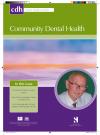Community Dental Health

- Cover Date:
- June 2013
- Print ISSN:
- 0265 539X
- Vol:
- 30
- Issue:
- 2
Editorial - What has oral health related quality of life ever done for us?
doi:10.1922/CDH_201302Tsakos02
Over the past 50 years, there has been a significant increase in life expectancy. At the population level, there has been a shift from a high prevalence of acute illness, with accompanying mortality, to a high burden of chronic illness in an aging population. There are within and between country variations in this trend, and there is evidence that the “improvement†in health has not been experienced equally across individual countries or regions of the globe. There is often significant morbidity associated with the consequences of chronic illnesses, and policymakers face major challenges in funding healthcare systems dominated by chronic disease management. While healthcare has been traditionally dominated by the measurement of pathological processes, it is now recognised that healthcare outcomes cannot be comprehensively assessed by objective measures alone. Whilst control of disease is important at individual and population level, the agenda for healthcare now includes the need to improve life quality as well as longevity. It is recognised that, for many people, the elimination of the consequences of disease is not achievable and such cases may benefit from shifting the focus of healthcare to palliation of symptoms rather than cure. To reflect this change, models of health have moved from a purely biological to more of a bio-psycho-social basis that places emphasis on outcomes rather than simply disease (Kaplan, 2003). Over the past 30 years, a variety of so-called “health-related quality of life†measures have been developed to enable patient-based assessment of health status to be incorporated in decision making. Oral health has been part of this trend and in 1996, a conference was held in North Carolina to discuss the plethora of newly developed “oral health related quality of life†(OHRQoL) measures that had emerged in the preceding years (Slade, 1997). This conference marked the beginning of an era of gradual acknowledgement of the importance of this field and the widespread use of these measures in research and practice. Like anything new, they have been perceived as the solution to many problems, some of which were clearly beyond the scope of these measures. The various instruments claim to measure the same construct but their focus is not without variation, illustrating the conceptual multiplicity of the insruments. They are not without their problems, as we will discuss.
- Article Price
- £15.00
- Institution Article Price
- £
- Page Start
- 66
- Page End
- 67
- Authors
- G. Tsakos, P.F. Allen, J.G. Steele
Articles from this issue
- Title
- Pg. Start
- Pg. End
- Barriers and facilitators that influence the delivery of prevention guidance in health service dental practice: A questionnaire study of practising dentists in southwest England
- 71
- 76
- Care home managers’ views of dental services for older people living in nursing and residential homes in inner city London
- 77
- 82
- Automated coaching to help parents increase their children’s brushing frequency: an exploratory trial
- 88
- 93
- Operationalisation of the construct of access to dental care: a position paper and proposed conceptual definitions
- 94
- 101
- Sociodemographic differences in oral health-related quality of life related to dental caries in Thai school children
- 112
- 118
- Short Communication - The cross cultural adaptation and validity of the Child-OIDP scale among school children in Karnataka, South India
- 124
- 126
- Short Communication - Defluoridation techniques implemented by the government of Karnataka, India – the current situation
- 127
- 128
